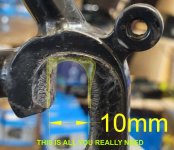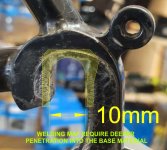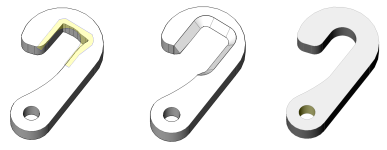LewTwo
1 MW
Not to my way of thinking. As someone previously mentioned, you have created 'stress risers' with those sharp corners. You need to reduce the stress at those points. Bonding additional material to the base material that bridges those corners reinforces it ... thus reducing the stress.MaximilianMM said:If you are filing the existing dropout with an adhesive or filler, I'm assuming that would not be strong enough on its own minus the plate? I guess the two just both add fortification.
One thing that I did not mention before is that picture looks to be the wrong way round to me ... I did not realize it was the "inside" of the frame. What you need is a flat surface to which to bond the new material. Good news is that you have a steel frame. That means you can spread the stays apart if needed (not recommended in the case of aluminum frames). My concern would then be the spacing between the derailurer and the sprockets. If you do both left and right sides of the frame then the spacing between the disk rotor and the caliper becomes an issue as well. Ideally this type of addition would be done on the 'outside' of the dropouts ... but someone mentioned that you have recesses ????MaximilianMM said:And can I confirm you are suggesting to attach that plate on the inside of the dropout as in the picture? I would then need to make sure I have enough clearance.
Take a long 10mm bolt and put a wrap of wax-paper round it. After the epoxy has set, drop the bolt out.MaximilianMM said:But as Markz said I suppose the plate and the original dropout would need to line up perfectly so that the force is on both.
That is the ideal solution, if you can find someone to do it properly with either steel welding (preferred) or bronze brazing. Otherwise this may a more practical solution .... and yes nothing wrong with extending the new metal a bit along the stays as long as it will not create any fitment or interference problems.MaximilianMM said:One thing I'm wondering about is the option of 'refilling' the existing dropout, which the mechanic mentioned and some others.
Does this mean anything to you guys? I don't really know what it would be, but I'm imagining it as a solution which uses the original dropout by adding back the filed metal with welding, rather than an exterior plate?
I once got a vintage Miyata 610 bicycle for a very good price. The original owner had an accident and broke the rear derailleur mount off. My solution was simple: Replace the rear hub with an Internally Geared Hub (which I prefer anyway). The point being, consider all the alternatives and choose the most practical.
If not for the pandemic then you could make a quick trip up to Thailand with the frame. Find any small bicycle shop in Pattaya or Phuket. They could fix it and have it back to you in a day or so as good as new .... of course they might add a 'noodle cart' to one side as well. :lol:




